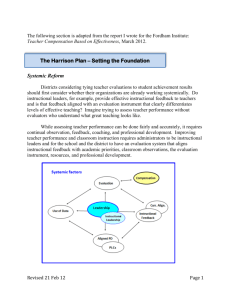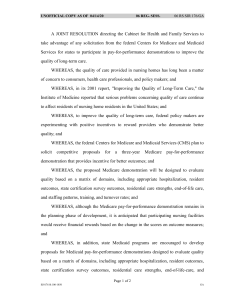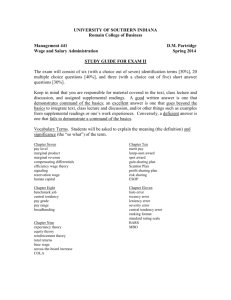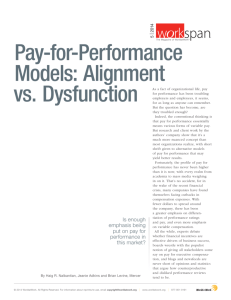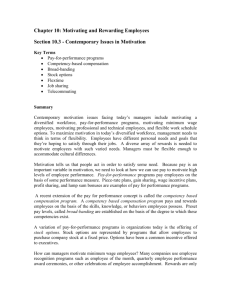Pay-for-Performance in the United States Health Care System:
advertisement
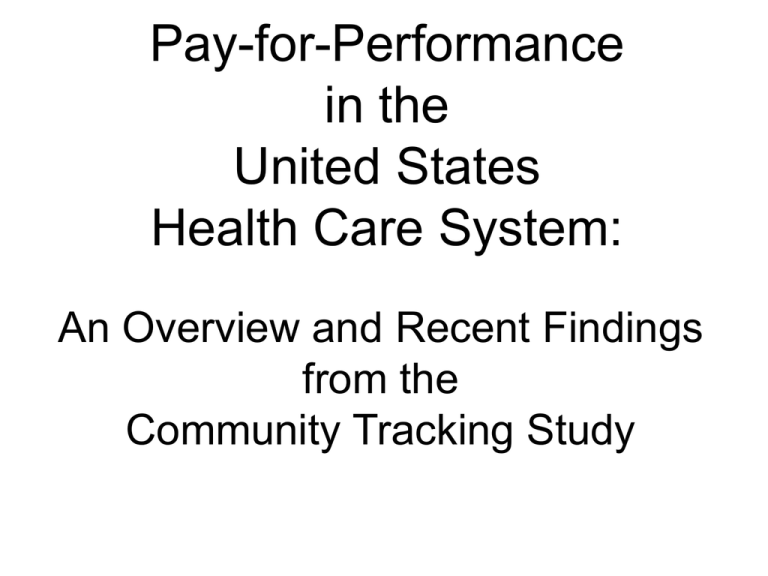
Pay-for-Performance in the United States Health Care System: An Overview and Recent Findings from the Community Tracking Study OVERVIEW: • Definition • Reasons for Increased Interest in Pay-forPerformance • Examples of Pay-for-Performance • Pay-for-Performance at the Market Level – the Community Tracking Study • The Future of Pay-for-Performance in the United States: Current Debate DEFINITION • Pay-for-performance is: “The use of incentives to encourage and reinforce the delivery of evidence-based practices and health system transformation that promote better outcomes as efficiently as possible” American Healthways, 2005 as quoted in Forrest, Villagra and Pope, American Journal of Managed Care, February, 2006 “Pay-for-performance represents the next great hopeor, in skeptics’ eyes, hype – for reforming the U.S. health system” Adler, Benefit News.com, October, 2005 Reasons for Increased Interest in Pay-for-Performance in the United States *Managed Care “Backlash” (1993-1997) *Decline in reliance on capitation payments due to: ־concern over incentives to withhold care ־shift in bargaining power between health plans and providers due to provider consolidation Physician Pushback Halverson: “…pricing power has shifted back to the consolidated, locally dominant providers, which are doing with that power exactly what we might expect: raising fees” Strunk, et al: “…financial pressures, coupled with greater sophistication in managed care contracting strategies and tactics, have spelled the end of a period when some providers uncritically accepted contract terms…providers are testing the waters to see just how far they can push their emerging bargaining power.” Reasons for Increased Interest in Pay-for-Performance in the United States continued • Institute of Medicine Spotlights Quality and Safety problems (1997-2000) – The IOM “To Err Is Human…” report underscored system failures that expose patients to unnecessary risks – The IOM “Crossing the Quality Chasm…” report and follow-up studies highlighted areas where current approaches to treatment are inadequate and substantial improvements in care are warranted; identified misaligned financial incentives as important cause of quality deficiencies – Quality deficiencies reinforced by McGlynn, et al. NEJM and Health Affairs articles Reasons for Increased Interest in Pay-for-Performance in the United States continued • Rising health insurance costs cause employers to search for new strategies to manage health care benefits • Pay-for-performance endorsed by highly visible national employers: “Pay-for-performance is here to stay. It will evolve and change over time, but already we know that it is working and we see that quality is improving. So to retreat to the previous system makes no sense to anyone. There is no turning back.” Francois de Brantes, program leader for healthcare initiatives with G.E. Corporate Healthcare and Medical Services Programs, quoted in Conklin and Weiss, Thomson-Medstat, 2005 Key Evolutionary Steps A Benefit Consultant Perspective Year 2002 Year 2012 Performance Disclosure • Comparisons of hospitals, physicians and pharmaceuticals Consumerism and Pay-for-Performance • Market sensitivity to hospital and physician performance Chasm Crossing • Clinical re-engineering by physicians and hospitals Improvement • 50 percentage points improvement in quality measures • 40 percentage point reduction in cost increases _____________ Source: Adapted from A. Milstein, MD, 2004 Reasons for Increased Interest in Pay-for-Performance in the United States continued • Improvement in information technology (1995 – present) -Growing implementation of the electronic medical record -HIPAA and the standardization of reporting cost and use of services Reasons for Increased Interest in Payfor-Performance in the United States continued • Rhetoric of Health Care Crisis ־Broder, Washington Post: “The American Health Care System is urgently in need of being overhauled” ־Senator Frist (R. Tennessee) The “…status quo of health care delivery is unacceptable today” and the health care sector needs to be “radically transformed” - Medicare budget pressures Pay-for-Performance: U.S. Examples (from 100+) CMS • Requires hospitals that participate in Medicare to report selected performance data to qualify for full payment; .4% penalty for non-reporting • 98% of Medicare hospitals report Integrated Healthcare Association’s P4P Initiative (California) • 6 plans, over 200 physician groups, 7 million commercial HMO enrollees • Standardized performance data and public report cards • Total payouts to high ranking groups will be $40 million to $100 million U.S. Examples Bridges to Excellence • Physicians who earn recognition via NCQA programs receive annual incentive payments of $50-$100 per employee or family member of participating employers • Rollout sites: Louisville, Cincinnati, Albany, Massachusetts • Major employers: GE, Raytheon, Proctor and Gamble, Verizon, UPS, Ford Pacific Care Health Systems: • In 2003, PacifiCare contracted with 300 large multispecialty physician organizations in California with groups providing care to an average of 10,000 enrollees each • PacifiCare had measured performance of groups on quality since 1993 and first made the information public in 1998 • New quality improvement program based on a subset of measures was announced in 2002 to become effective in 2003 contracts • 163 groups had enough PacifiCare patients to be eligible for the program Pacific Care Health Systems continued KEY COMPONENTS OF THE PROGRAM • Performance targets set at 75th percentile of 2002 average performance of groups • Groups received a bonus of 23 cents PMPM for each target met or exceeded • Overall, groups with 10,000 PacifiCare enrollees could receive $270,000 annually for perfect performance – This was about 5% of the professional capitation paid by PacifiCare to average group and 0.8% of overall group revenue • Performance assessed on rolling year of data and payments made quarterly • Groups anticipated that other plans soon would implement similar programs Pacific Care Health Systems continued OUTCOMES • Improvement occurred in all three quality measures studied but this also was true for PacifiCare provider groups in a comparison area (Pacific Northwest) – For only one measure, there was a significant difference in the rate of improvement • In the first year, PacifiCare awarded $3.4 million out of $12.9 million in potential bonus payments • 60% of groups received payments initially and this increased to 75% after one year; only 14 groups received payment for 5 or more (out of ten) measures • High performing groups, prior to the program, received most of the bonus money but improved the least __________ Source: Rosenthal, JAMA, October 12, 2005 Pay-for-Performance at the Market Level – The Community Tracking Study • Background – Goal of CTS: Better understanding of how health systems change over time at the community level and how marketspecific factors influence change across different communities – Design: • 12 randomly selected communities (1996) • Surveys of providers and consumers • Site visits for collection of interview data every two years – Most recent site visits: • January – June 2005 • Over 1,000 interviews using structured protocols • Representatives of provider organizations, health plans, large employers, third party administrators, benefit consultants, health insurance brokers • Multiple interviews with the three largest health plans in each community – Funding: The Robert Wood Johnson Foundation (Principal) Employer (Agent) Health Plan (Principal) (Principal) Medical Group (Agent) (Agent) Physician Pay-for-Performance at the Market Level – The Community Tracking Study • Employers – Local benefit managers had limited interest in health plan pay-for-performance efforts • Saw these efforts as a normal part of “network maintenance” • More focused on shifting costs to consumers, implementing disease management and wellness programs – Benefit managers who were aware of pay-forperformance efforts were often skeptical – Some employer involvement in community efforts to encourage collaboration among plans in defining performance measures (eq Phoenix, Seattle) Pay-for-Performance at the Market Level – The Community Tracking Study (continued) • Health Plans – 27 of 34 Plans had pay-for-performance programs, pilot efforts or planning stage efforts – Plans not developing pay-for-performance initiatives: • Were focusing instead on changing consumer behavior • Didn’t have resources necessary to mount program • Were waiting for direction from corporate offices Pay-for-Performance at the Market Level – The Community Tracking Study (continued) • Health Plans (continued) – Broad range of measures in use, including many that are efficiency-related – Local market relations between providers and plans shape pay-for-performance implementation – Money at stake ranges from small to substantial sums • Miami plan: $4,000 per physician is average award with maximum award of $12,000 • Growing consensus that plans need to have at least 10% of provider compensation tied to pay-for-performance to get a response – Substantial variation across programs in percent of providers receiving bonuses – Few plans risk adjust or have a strategy for evaluating impact Pay-for-Performance at the Market Level – The Community Tracking Study (continued) • Providers – Gaining provider acceptance of pay-for-performance is major health plan challenge – Providers voice support in theory but negotiating details has gone slowly – Local plans have emphasized a collaborative approach – Provider concerns include: • • • • Choice of measures Administrative burden In-consistencies across health plan approaches Sample size on which measures are calculated (for physicians) Pay-for-Performance at the Market Level – The Community Tracking Study (continued) • Providers continued – Communities where most physicians practice in organized medical groups are further along in implementing pay-for-performance for physicians – Orange County • Integrated Health Care Association has developed pay-for-performance for HMO patients • California Blue Cross has developed pay-for-performance for its PPO patients • Health plans’ pay-for-performance money is added to medical group bonus pools for physicians with distribution to frontline physicians being highly variable – Boston • • • • The three largest plans include Pay-for-performance in physician contracts About half of pay-for-performance dollars reward cost containment Frontline physician awareness of pay-for-performance is minima\ New money or “withheld” dollars? Pay-for-Performance at the Market Level – The Community Tracking Study (continued) • Summary – Implementation of pay-for-performance is highly variable across communities depending on local market characteristics – No consensus has emerged on key issues: • Measures to be used • Dollars needed to stimulate behavior change – Medical groups play an important role in implementation of physician pay-for-performance programs and their subsequent impact – Disconnect between public support expressed for pay-for-performance by large, national employers and awareness and support on part of local employers – Pay-for-performance further along for hospitals than physicians – Evaluation of effectiveness is generally missing The Future if Pay-for-Performance in the United States: Current Debate • Standardization of measures at the national level versus negotiated solutions at the local level • The role of organized medicine – AMA “pact” with Congress on Medicare pay-forperformance – specialty society response • Medicare support for pay-for-performance – de-facto standardization? -- will health plans mimic Medicare?
